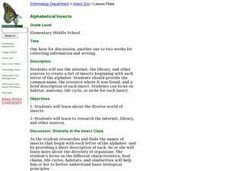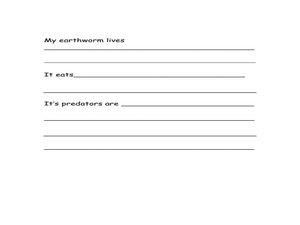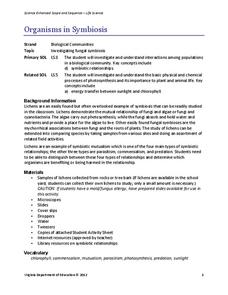Curated OER
Alphabetical Insects
Students research using the internet, the library, and other sources to create a list of insects beginning with each letter of the alphabet. They provide the common name, the resource where it was found, and a brief description of each...
Curated OER
Insect Biodiversity
Learners examine biodiversity by conducting comparative biodiversity surveys. They conduct Internet research to identify insects that they have caught in two different habitats, and compare the biodiversity of the two areas.
Curated OER
Insects and Spiders
Students make either and insect or a spider using materials their teacher provides. They then draw of picture of their organism and defend why it is either a spider or an insect.
Curated OER
Insect Collection
Students investigate about various biological aspects of life, while examining desert insect species. They see the diverse range of species that live in the desert, despite the apparent lack of life in the desert. students tocomprehend...
Curated OER
Insect Classification
Students compare and contrast the visible structures of three insects based on photographs. They differentiate characteristics of crane flies, ants, and wasps then create a simple classification system.
Curated OER
Chain Reaction
Students read a magazine on chain reaction and complete an included crossword puzzle. They select one interesting fact they learned and share it with the class, playing a game of truths and lie. Next, the students create 3 statements,...
Curated OER
Darwin’s Bees
What do you call a bee born in May? A maybe! This first instructional activity in a series of four begins with a starter activity to get scholars thinking about the topic. Then a circus, or circuit of seven activities, show Darwin's...
Curated OER
Interpreting a Flowchart
Students examine insects place in a community. They discover the communities of insects.
Curated OER
Earthworms and Making a Wormery
Students explore the environment by researching insects. In this earthworm lesson, students utilize soil and plexiglass to build a see through wormery in which students can observe the worms at work. Students identify the benefits of...
Curated OER
What Kind of Insect is That?
Fifth graders characterize insects and classify insects according to the Linnaean system. They use hand lenses or microscopes to examine insect body parts.
Curated OER
Adopt-An-Insect
In this biology instructional activity, learners locate examples of various types of insects listed in the chart and receive a point value for each according to its significance. Then they identify body parts and habitat for each item.
Curated OER
Adopt-An-Insect Bingo
In this biology instructional activity, students select twenty-five terms relating to insects to complete their bingo card as listed on the sheet. Then they match each name or family with its correct description.
Curated OER
Discovering Insects
First graders identify insects and name nine commonly known insects.
Curated OER
Identifying Insects
Students collect samples of insects and identify them. They evaluate water conditions that causes species to be found in streams and listen to sounds of water through music. Next, they respond to the music and discuss their reactions.
Curated OER
Insect Monitoring
Students practice the scientific method in the classroom, either in preparation or as a substitution for real-world field experience. They examine a simulated biodiversity research situation, using a "mini-plot" or
sampling square...
Curated OER
Science - Learning About Migration
For this animal migration worksheet, students learn about animals that migrate. They then answer the 11 questions on the worksheet. The answers are on the last page of the packet.
American Museum of Natural History
Wonderful World of Wasps
Shockingly, wasps sometimes challenge lions as the king of predators! Learners explore the life of a wasp in an interactive online lesson. They read about the characteristics of wasps and then complete activities to learn about their lives.
Cornell University
Field Day: Be an IPM Detective
Become a pest detective! Individually or in small groups, scholars scout the land to discover which pests—plant and animal—inhabit it, determine whether the pests are endangering the environment, and summarize their findings.
Cornell University
Weed IPM
Go on a weed hunt! Scholars gain insight into the characteristics of plants and examine the outdoor environment in order to identify five different types of weeds. Learners then show what they know with a one-page reflection.
Chymist
Landfills and Recycling
Examine the nature of landfills through experimentation. Scholars build miniature landfills and monitor changes over a six-week period. Observations allow individuals to draw conclusions about the different types of trash and their...
Ask a Biologist
The Many Faces of Ants
Though they be but little, they are fierce! Young biologists read about eight different species of ants, and discover how the anatomy of their heads can explain the way they live and what they eat.
National Security Agency
Place Value - Butterflies Floating Place to Place
Learn about butterflies and place value in a series of interdisciplinary lessons! With several worksheets that reference butterfly facts in word problems, kids can practice science and math in one activity. Additional worksheets are...
Virginia Department of Education
Organisms in Symbiosis
Searching for an activity that allows emerging biologists to explore symbiosis up close and personal? Pupils collect samples and view lichens through a microscope and conclude with a discussion about the relationship they have with other...
Curated OER
What Flies?
Young learners consider what flies and what kinds of sounds airplanes, animals, etc. make when they fly. They also get to generate a brainstorm list. Children discuss what the categories should be once the list is completed. Some really...
Other popular searches
- K 2 Life Science Insects
- Science Insects
- Parts of Insects Science
- Life Science Insects
- Science Spiders vs Insects
- Esl Lessons Science Insects
- Esl Science Insects

























